Summer is here and it is sure to be the best many of us have ever had. It will certainly be a lot more carefree than last year, and that means a lot of time outdoors with loved ones. Last summer I did a fun series on the history of beach culture in America and how we went from women hiding in bathing machines to the string bikini in just a few decades. As the temperatures have started to warm up and I have begun shopping for extra gear to use to enjoy basking in the sun, I realized that my desire for a post-Covid tan is a trend in and of itself. White Victorian women didn’t just keep covered head to toe for modesty, they sought to keep their skin looking as though it hadn’t seen the light of day. It was a fashion.
Is there a history of the suntan?
Yes, indeed! And it involved a lot more than women simply adapting small swimsuits. By the time it became acceptable, it was considered to be just as important as any other accessory or grooming practice. The real heyday for the suntan came in the 1920s, when even clothing was designed to accommodate tan lines.
Let’s take a look!
The fairest lady in the land: the Victorian fear of the suntan
While ancient civilizations may have worshiped the sun, the Western world of the Victorian era preferred to be shielded from it. Many history bloggers write that white Victorian women valued pale skin because it separated them from the working class, but I think this is just one explanation. It was a standard of beauty that also demonstrated that a woman had many of the valued female qualities of the day; calm, concerned about maintaining the codes of conduct, content to remain indoors, happy to follow prescribed rules about leisure time, and above all, modest. I might even venture to say that the modesty aspect was just as important as that of appearing to be wealthy and therefore able to spend the say inside. After all, even female workers of the time would have done much of their work indoors. It was not the paleness of one’s skin that would have differentiated a wealthy woman from a working-class woman.
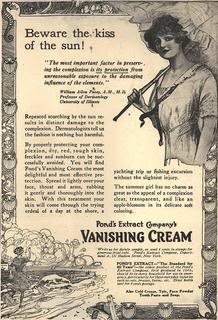
But I digress.
For whatever reason, pale skin had been a hallmark of refinement for white women for centuries. Not only did they only venture outdoors when covered head to toe, but efforts were also taken to lighten the skin. The wonderful Mimi Matthews has a blog post about such toiletries and how some Victorian women used items from the kitchen to speed up the fading of one’s tan or remove freckles. For freckles, one might have tried strawberry water or the following recipe for lemon cream:
“Put two spoonfuls of fresh cream into half a pint of new milk; squeeze into it the juice of a lemon, and half a glass of brandy, a little alum, and loaf sugar; boil the whole, skim it well, and, when cool, it will be fit for use.”
-New Household Receipt-Book, 1854
Besides the alum, I’d say I’d like a glass of that concoction!
Mimi Matthews also educated me on the efforts taken to prevent a tan. I found this surprising considering how much clothing a Victorian woman would wear when leaving the house. It is a good indication of just how highly the pale skin was prized.
Preventative Wash for Sunburns:
“Take two drachms of borax, one drachm of Roman alum, one drachm of camphor, half an ounce of sugar-candy, and one pound of ox-gall; mix and stir well together, and repeat the stirring three or four times a day, until the mixture becomes transparent; then strain it through a filtering paper, and it is fir for use.” -New Household Receipt-Book, 1854
This recipe sounds like it would scrub the top layer of one’s skin off!
Sunbathing is invented
A massive shift happened as the 19th century was coming to a close. While previously spending time in one’s home and in the homes of friends was a sign of one’s social status, leisurely outdoor activities were quickly becoming popular. One of the first activities to trend was sunbathing. A growing interest in the health benefits of the sun was mixed with changing standards of modesty and a growing desire to mingle with the opposite sex. By the 1920s, men were appearing on the beach topless and women were showing more leg with each passing year. The wealthy were taking beach holidays for the first time ever. Exposing the skin to the sun had become chic. And then, some began to notice that tan skin had an appeal that they hadn’t noticed before.
Credit to Coco Chanel?
I can’t get around discussing the history of the suntan without mentioning Coco Chanel. Every single blog post and article I read o the topic refers to her being responsible for normalizing bronzed skin. The legend is that after enjoying a vacation in the French Riveria, she returned home and was quickly photographed, revealing her tan. And boom – everyone wanted to be like her and thus decided to begin lounging in the sun despite hundreds of years of valuing pale skin.
I find it interesting that so many people could give so much weight to such a simple explanation. If Chanel was enjoying the sun on her holiday so much so that she came back with a tan it is only because it was already acceptable to wear smaller swimsuits. It was already acceptable to lounge in the sun uncovered. She only allowed herself to be seen in public bearing tanned skin because it was an acceptable thing to do.
In truth, a friend of Chanel’s gave her credit for “inventing” the suntan during an interview with Madmoisele in 1971. I could find no previous reference to the photograph or the overnight popularity that it is said to have caused.
Women were just enjoying experimenting with what sun could do to their skin and Chanel was no exception.
The 1920s: drink up the sun!
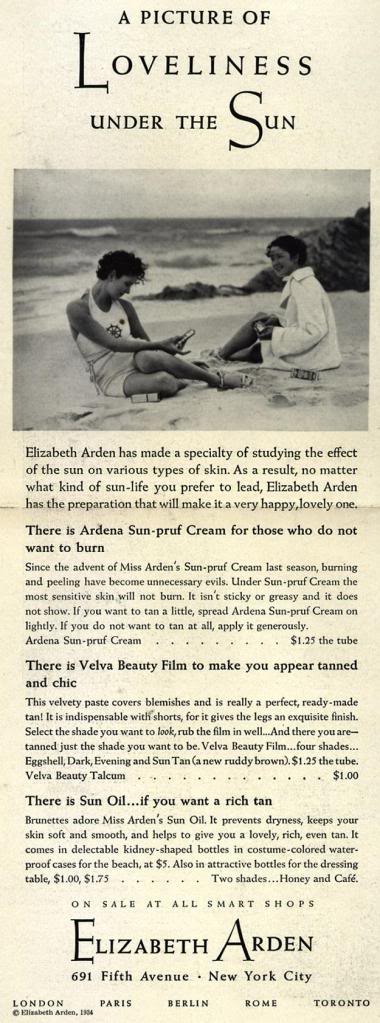
Trends that would have never been conceivable were very quick to catch on in the late 1910s and 1920s. In the 1890s something like a woman bearing her midriff in public was unimaginable. Drinking in public was forbidden for women. Socializing with members of the opposite sex without a chaperone was scandalous. In the 1920s, this all became fashionable. Status started to become less about one’s family or fortune and more about one’s use of autonomy.
Lounging in the sun was pleasant, and that was that. Still, women were encouraged to stay mostly covered. Large hats, flowing dresses, and large umbrellas were necessary gear for enjoying a day on the beach. Advertisements from the early 1920s do indeed show women enjoying themselves near the waves, but they are largely promoting shielding of the skin while doing so. With each passing year, however, women’s magazines promoted more and more skin as being respectable. By 1928 the tide had really turned. Instead of encouraging women to be mindful of their skin while being outdoors, magazines featured advertisements and articles on how to maximize time in the sun and get the best tan possible.
My theory is that the rapid change wasn’t just about evolving standards for modesty but rather than the more time people spent outdoors in warm temperatures the more they realized how much more enjoyable it is to do so with the least amount of clothing possible.
Are you in, or out?
Before long, the tan was in. Coco Chanel, while perhaps not being as responsible for the trend as some give her credit for, was quoted in a 1929 issue of Vogue as saying “The 1929 girl must be tanned. A golden tan is the index of chic.”
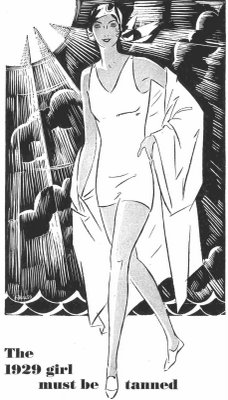
All time spent outdoors was seen as an opportunity to improve one’s tan. What I don’t think a lot of people realize is that enormous effort was made to accommodate the new trend of bronzed skin. If you think we favor tans as the preferred look today, you should have seen how the world responded to this newfound option in the 1920s!
Dresses themselves were often designed to help a woman tan the neckline and bust. I have also read that the sudden appearance of the backless dress was partially a result of women wanting to show off their all-over tans. Such scarcity in fabric was not just to allow for more tan, but to show off that one had one. A 1929 Delineator article read:
“Most important of all in choosing your wardrobe is the necessity of being true to your tan and its outline. This season lingerie foundation garments, pajama suits, and all your frocks may be either V, U. or square neck style, for tan is truly the maker of fashion, and the whole apparel gamut has been designed to admit that it’s smart to be healthy, to let the sun have its way.” -Lucile Babcock
Sun-kissed skin became not just a trend but a standard. A 1929 advertisement read: “Do you tan evenly – or do you burn, peel, freckle and curse? Do you lose your tan between outings and look moth-eaten? … Don’t be old fashioned – just rub on the marvellous new Glory of the Sun Powder – smooth it in – and have a perfect tan in two minutes. So natural – nobody guesses it came out of a box. ”
In less than a decade, the norm had gone from attempting to keep skin as pale as possible to judging a non-tanned white woman as looking moth-eaten.
And if you were questioning how wide-spread the trend was, consider that even breakfast cereal was judged by its similarity to a tanned body:
“Beautiful sunbrowned bodies! Delicious sun-browned Wheatena! What pictures of health! The same natural rays of the sun that brown your skin—that pour health into your body—also give Wheatena its color and its wholesomeness.”
Advertisement for Wheatena cereal, Ladies’ Home Journal, 1929
There was no avoiding the suntan. Instead, the media and cosmetic companies decided to jump on the growing popularity of summer culture. By the time Coppertone introduced the sunkissed child on its bottles in 1953 sunbathing and controlling a suntan had become the billion dollar industry that it remains today.
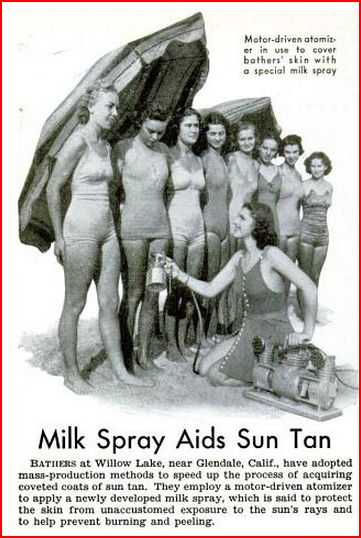
You may also enjoy:
The Introduction of the Bikini

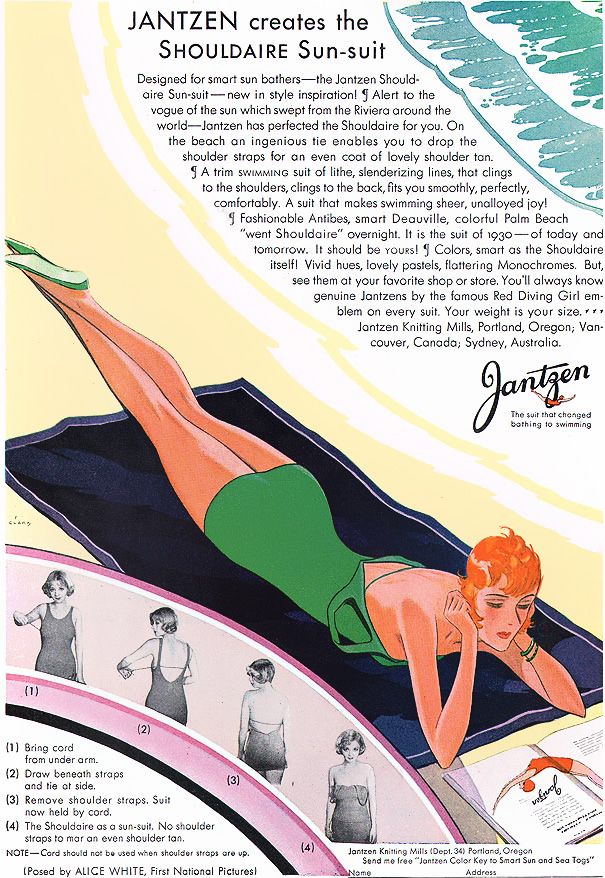


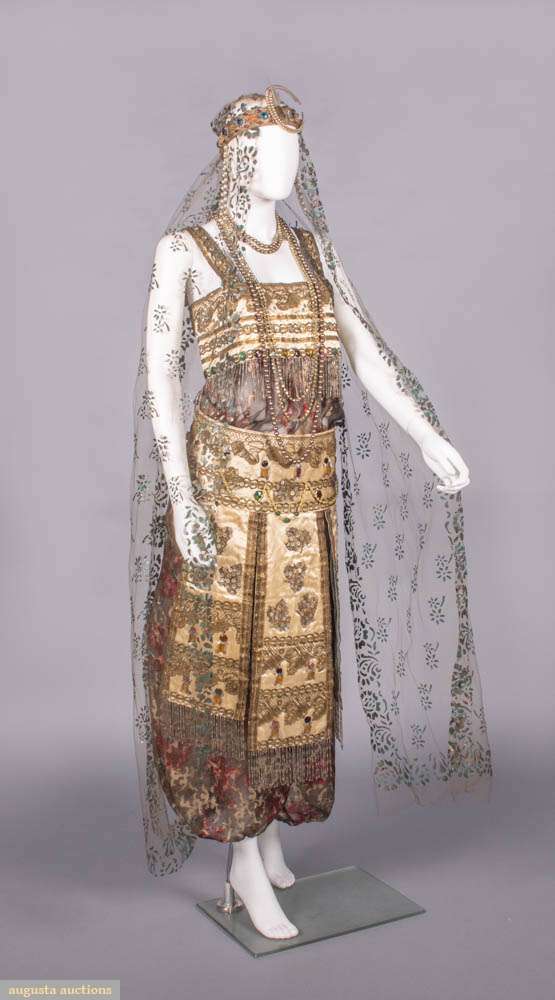









Leave A Comment